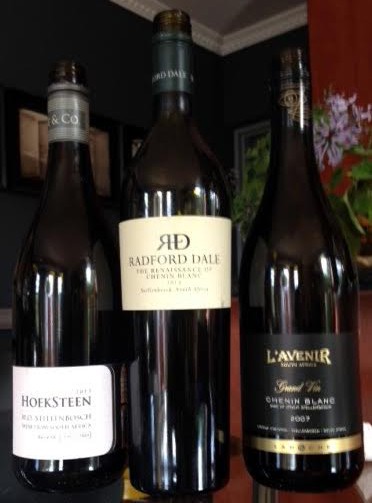Tim James: The Joys of Stellenbosch Chenin Blanc
By Christian Eedes, 6 April 2015
 With fashionable Swartland basing its white wine reputation on its treasure-house of old chenin and getting a lot of deserved attention for its varietal wines and blends, it’s perhaps not always remembered just how brilliant many Stellenbosch chenins are. Even that great Swartland champion, Eben Sadie, takes his priciest white wine, Mev Kirsten, off an ancient Stellenbosch chenin vineyard.
With fashionable Swartland basing its white wine reputation on its treasure-house of old chenin and getting a lot of deserved attention for its varietal wines and blends, it’s perhaps not always remembered just how brilliant many Stellenbosch chenins are. Even that great Swartland champion, Eben Sadie, takes his priciest white wine, Mev Kirsten, off an ancient Stellenbosch chenin vineyard.
I was reminded of the quality of Stellenbosch chenin three times in the last week, with bottles drunk to the last drop (all with screwcaps, I realised when I posed them for a photo).
The most interesting to try was L’Avenir Grand Vin Chenin Blanc 2007. The “Grand Vin” bit was introduced for this vintage – and abandoned some five years later. L’Avenir was one of the early wineries to take chenin seriously and achieve some measure of fame for it, and for winemaker Francois Naudé. Its second bottling, the 1997, won Wine Magazine’s Chenin Blanc Challenge (founded three years earlier, and important in building chenin’s reputation and, more problematically, encouraging for some time dominant blockbuster style with sweetness and oak). Platter’S wrote enthusiastically of the 1998, saying that “this chenin’s consistency gives greater credibility to [the] local rally behind [the] variety”.
In those days the L’Avenirs had no oak, but were off-dry, and often with a botrytised component. The more ambitious 2007 Grand Vin, off a vineyard planted over 30 years earlier, had six months in older oak, and 8g/litre of residual sugar. I described the sweetness at the time as “hidden in the fine balance”, and it remained so. My recent bottle was beautifully poised and harmonious, full of life in the early stages of tertiary development; I can’t see any reason why this wine shouldn’t develop further and complete its decade, at least. Sure, it might well have been a finer, fresher wine with a little less richness – but that’s not what it was designed for. I only wish I had more bottles of it to drink over coming years. Incidentally, the current version of the wine, which I haven’t tried, looks to be much oakier.
Somewhat less mature was Radford Dale Renaissance Chenin Blanc 2012. It was an altogether different experience: more delicate and restrained than the L’Avenir, even a touch austere, properly dry and with its oaking (mostly older barrels) well integrated; with a fairly vibrant acidity. It opened up somewhat on the second day, but is the opposite of a blockbuster – light, elegant and charming, quiet and even demure. I would be interested to try this when it’s as old as the L’Avenir – I suspect it won’t have aged as well, but I wouldn’t bet a lot on that suspicion. It’s certainly very drinkable now.
The wine that set me off on this Stellenbosch exploration was the HoekSteen 2013, from Fledge and Co – the adventurous label of Boplaas winemaker Margaux Nel and partner Leon Coetzee (the winemaker who writes me by far the most voluminous – always interesting – emails of any, and insists on respectfully addressing me as Mr James). The pair source small volumes of grapes from here and there, including from old chenin bushvines in Stellenbosch. The name, incidentally, is wittier than non-Afrikaans-speakers might realise: hoeksteen means cornerstone, and steen, of course is the traditional local name for chenin.
I really love this unoaked, beautifully fresh, flavoursome wine. Dry, and with an alcohol level scarcely over 13% (a touch more than Radford Dale Renaissance and definitely less than L’Avenir) it’s got great balance. The eight or so months since I last tasted it have done only good, bringing out the flavours above the mineral finesse, and it has a future too. Fascinating, thrilling, and delicious – what more could one ask?
- Tim James is founder of Grape.co.za and contributes to various local and international wine publications. He is a taster (and associate editor) for Platter’s. His book Wines of South Africa – Tradition and Revolution appeared in 2013.







Comments
0 comment(s)
Please read our Comments Policy here.